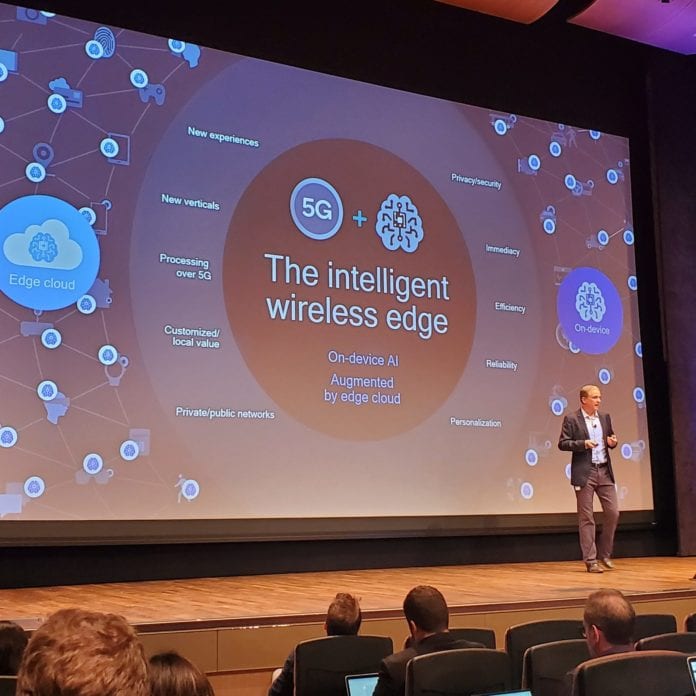SAN DIEGO–With 5G poised to change the world, Qualcomm is fine-tuning its strategy to take the tech from handsets and the enhanced mobile broadband use case on to vertical enablement requiring the full scope of 5G, which is that eMBB component along with support for massive internet of things and ultra reliable, low latency communications.
At the Future of 5G workshop, executives highlighted the company’s foundational role as an R&D powerhouse that feeds its learnings into the 3GPP standardization process, and, with 5G networks popping up around the world and set to scale out in 2020, Qualcomm discussed how it will continue to help drive growth in consumer adoption while also honing its product set to address high-value vertical markets like automotive and manufacturing.
But prior to diving into the future of 5G, CTO Jim Thompson took media and analysts assembled in Irwin R. Jacobs Qualcomm Hall through a “wormhole,” tracing the company’s role in the development of what would become 5G starting in 2014 when it laid out a vision of 5G as based on OFDM and with baked-in support for both sub-6 GHz and millimeter wave frequencies.
Thompson, who described himself as a Qualcomm “lifer,” discussed the company’s long-term, strategic planning efforts and said, “We work on stuff way ahead of time. Sometimes it works out, sometimes it doesn’t, sometimes it morphs into something else.”
2014, he continued, is “really when the industry got together and said, ‘Hey, what is 5G going to be?’ Our vision was we would create a single system, not multiple systems…where you could put all of these services together.”
Verizon launched a very limited proprietary 5G fixed wireless access service using its millimeter wave spectrum in third quarter last year. Since then, the carrier has stood up a mobility service using the same high-band spectrum as has AT&T and T-Mobile US, despite the latter expending a huge amount of marketing capital bashing its competitors millimeter wave-based approach to 5G roll out.
The groundwork for all of that that started five years ago when, in November 2015, when Qualcomm demonstrated a TDD transmission in the 28 GHz band. In a contemporaneous blog post, the company noted the challenges associated with mobilizing millimeter wave. “To enable a good mobile broadband user experience with mmWave requires continuous intelligent beam searching and tracking algorithms to discover and switch to the dominant beam path.”
In 2016 at an event in Hong Kong, Qualcomm announced the X50 5G modem which, a few years later, would go into commercial handsets alongside a gigabit LTE modem and other components. At the time, company President Cristiano Amon said the announcement “heralds the arrival of 5G as operators and OEMs reach the cellular network and device testing phase…This shows we’re not just talking about 5G, we’re truly committed to it.”
2017 was quite the hit parade:
- In October, Qualcomm achieved a 5G data connection in 28 GHz using the X50 and previewed a smartphone reference design for testing purposes.
- The next month, the company worked with China Mobile and ZTE to conducted end-to-end interoperability testing of what would become the 5G New Radio standard.
- And, in December, 3GPP, which Qualcomm is a major contributor to, completed the “first implementable 5G NR specification,” and highlighted that the pace of development could lead to commercial deployments “as early as” 2019; that one got checked off early.
2018, as you know, was jam-packed in terms of the telecom industry ramping for 5G commercialization. Here’s a summary from Qualcomm: “We completed 5G NR interoperability testing and conducted field trials with our ecosystem partners. We crossed many key milestones to prepare us for commercial 5G launches, such as the mmWave RF module for smartphone form factors, in order to provide users across the globe with multi-Gigabit speeds, ultra-low latency and virtually unlimited capacity in 2019.”
And that brings us to 2019–I’ve got a 5G capable phone in my bag and have used it on live networks in a few U.S. cities while my colleagues have done the same around the world. Also, the point of Thompson’s presentation, I think, was to reiterate that Qualcomm is a helluva lot more than a chipset vendor.
Editor’s note: There’s a trash allusion in here to a forgettable British band from about a half-century ago, so enjoy that.

